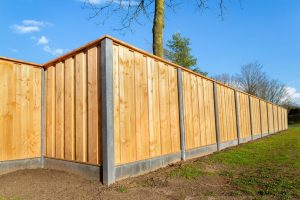
Wood fences were only pre-dated by piled stone and hedge fences and have been used for centuries in many cultures. Originally, wood fences were an economical and time-saving method to keep cattle, and other livestock contained. Over the years, wood fences have been improved upon, with many styles and applications developed for modern uses.
We will review a few of the more popular wood fences available on the market today.
Pressure Treated Wood Fences
Pressure treated wood fences are considered one of the most popular types of fences available today. Pressure treated wood lasts longer than regular wood because it is chemically treated. The wood is dunked into a chemical bath and then put into a chamber. The chamber uses pressure so that the chemicals are forced into the center-most part of the wood. Pressure treated wood fences can last up to 25 years. The one thing with pressure treated wood fences is that the chemicals used might pose some concern. If you are planning to install your own fencing, it is best to take the proper precautions.
Pressure treated pine is the most commonly used type of wood for PTW fencing. The pine is not expensive but will still hold up for years. PTP is economical and affordable. Hiring a contractor to put up your fencing is an option that many people take advantage of. Have the contractor come out to you, and you can discuss the design you want. The contractor will let you know what materials you will need and the cost of labour. There will be add-ons like gates and hinges. Make sure the contractor you decide to hire gives you a written estimate. If you feel that you are not getting a good price, this is the time to get another estimate from another contractor.
Eastern White Cedar Fences
Eastern White Cedar Fences have long been known for their elegance. One of the best things about this type of fencing is that it does not have to be treated with any chemicals before being used. Instead, white Cedar has its own natural oils that keep the bugs away and repel moisture. Cedar fences also give off a very pleasing scent. Although a bit more costly than pressure treated wood, it is well worth the investment aesthetically and environmentally.
Western Red Cedar Fences
Western Red Cedar fences are both durable and beautiful. Red cedar will last for many years and can take paint or stain. Red Cedar is used without having to be treated with chemicals first because of its natural oils. People who want a fence and be environmentally friendly choose this type of wood for the fencing. Western Red Cedar fencing will last for many years and naturally repels insects.
Pricing for Wood Fences
The pricing of the materials used for wooden fences will vary, with pressure treated pine being the least expensive. Choosing your fencing materials is strictly a personal decision, as the panels can be put together in various configurations. Your choice will depend on a few factors, like the size of your budget, the design which appeals to you and the size of the area you want fenced in. Wood fences add charm and character to any landscape. Whether you want a traditional older look or a clean, crisp contemporary feel for your property, both can be achieved with wood fences.
Now that you know all about the different styles of wood fences, here are a few key tips to help maintain them:
Inspect and Repair Your Fence Annually
No matter what type of fence you end up with, inspecting it each year is a good way to maintain it and help it last even longer. When walking around your yard, look out for any damage. This could include signs of leaning, rot, or insects. If any sections have chips, cracks, or splits, seal them up by using wood glue to prevent moisture damage. If the posts don’t feel firm and secure in the ground, they might need to be replaced.
Clean the Wood Every Three Years
Every three years, use a pressure washer to clean the fence to remove any build-up of dirt or mildew. You might need to scrape away the moss of it’s grown on the wood. Combine 20% bleach with 80% of dish soap to spray on any mouldy spots. Once it’s clean, apply a water-repellent coating.
Reseal or Paint
After cleaning the fence, you could add a stain or a coat of paint to seal it up thoroughly. Just be sure to use latex paint or an exterior oil-based stain that has a UV inhibitor. This will protect it from the weather elements and reduce the likelihood of mould and mildew from developing again.
Adjust Sprinkler System
Even pressure-treated wood can still be somewhat vulnerable to moisture damage. If you have a sprinkler system, make sure it is directed away from the fence to prevent moss and wood rot. When you need to water any vegetation near or around the fence, double-check that there is sufficient drainage to prevent pooling water from impacting the wood panels and posts.
Trim Back Vegetation
If your yard has lots of vegetation and trees that touch or hang over the fence, trim these back so there’s a bit of distance in between. These can add weight to the fence if they’re hanging on it and trap in moisture, leading to mould, mildew, and other problems.
Give Us a Call
If you notice any sections that need repair, give us a call. Even minor issues can end up leading to costly repairs or replacements if they’re ignored. Save money and aggravation by addressing any problems as soon as possible to keep your fence in pristine condition.
Along with fence installation of any kind, we also offer repair services for most fence types. To learn more about this, visit our Fence Repair page.

